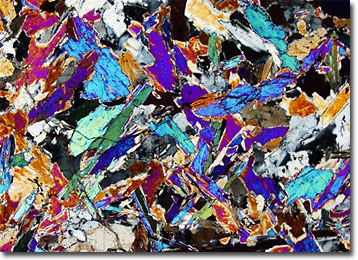Polarized Light Microscopy Digital Image Gallery
Cordierite Anthophyllite Skarn
Skarns are a type of rock that develops in the vicinity of igneous intrusions when sizable amounts of aluminum, silicon, iron, and magnesium are introduced to limestone or other sedimentary rocks chiefly composed of carbonates. Skarns may contain a wide variety of minerals, including those of economically important ores, such as copper.

Cordierite is a blue magnesium aluminosilicate mineral that is sometimes utilized as a gemstone. Indeed, samples that have been procured from Sri Lanka are sometimes referred to as water sapphires. A synthetic variety of the mineral, however, which has a very low coefficient of thermal expansion and excellent resistance to thermal shock, is primarily used in items such as electrical insulators and high performance resistors. Among the other notable characteristics of cordierite is its pronounced pleochroism, or propensity to exhibit different colors when viewed along different axes. In fact, this aspect of cordierite is the origin of its alternate name, dichroite.
Among the minerals that are often associated with cordierite is anthophyllite, a member of the amphibole group. Commonly found in metamorphic and metasomatic rocks, anthophyllite derives its name from the Latin word for “clove,” a reference to its characteristic clove-brown coloration. The mineral occurs in both prismatic and fibrous crystalline forms, the latter of which is sometimes utilized as asbestos. Some of the most notable deposits of anthophyllite are located in Montana, Pennsylvania, Canada, Greenland, and Italy.
